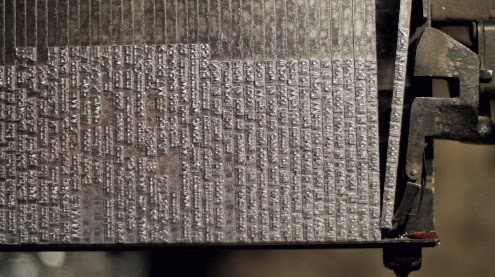Karin is one smart cookie! She wins again with her 9:35 a.m. Tuesday guess "Linotype operator at Pasadena Star News, perhaps mid-century."
In the 1973 photo above, Don Phillips operates a Linotype machine in the basement of the Pasadena Star-News building* at 525 E. Colorado Blvd.
For decades just about every newspaper, magazine, publishing house and printing firm in the western world used Linotype machines, invented in 1884 by German watchmaker Ottmar Mergenthaler.
Every time a trained operator like Don Phillips touched a key on the typewriter-style keyboard, a matrix with the corresponding indented letter would drop into an assembler. When the matrices for an entire line were assembled, the line was automatically justified and molten metal cast "slugs" would be organized line by line into columns and pages for the purposes of printing.
This could be done at a rate of 1,000 words per hour or 14 lines per minute.
Thomas Edison called the Linotype machine the eighth wonder of the world because it revolutionized the printing industry.
Prior to Linotype there was moveable type, invented by Johannes Gutenberg in 1436, that created a sea change in western civilization.
Even as late as the 1930s moveable type was still in use at some newspapers where type was still being set by hand, one painstaking letter and punctuation mark at a time. These newspapers were limited to a maximum of eight pages -- the number of pages that could be typeset at a snail's pace in a day's time.
By 2000 printing technology changed again, switching from mechanical hardware to digital software.
This trailer for the documentary "Linotype: The Film" is quick and fun to watch.
And this CBS Sunday Morning video is a great example of how a Linotype machine works.
* 1927 photo of the 63,863-square-foot Pasadena Star-News building, designed by Joseph Blick in 1924 in a Beaux-Arts style and completed in 1925. The building is listed in the National Register of Historic Places. The radio towers on the roof belonged to KPSN Radio, operated by the Pasadena Star-News for two years in the 1920s. Pasadena Star-News offices are now at 911 E. Colorado Blvd.
Many thanks to the Pasadena Star-News, Pasadena Museum of History, Shorpy Archives, The Prothero Press and International Printing Museum.
Every time a trained operator like Don Phillips touched a key on the typewriter-style keyboard, a matrix with the corresponding indented letter would drop into an assembler. When the matrices for an entire line were assembled, the line was automatically justified and molten metal cast "slugs" would be organized line by line into columns and pages for the purposes of printing.
This could be done at a rate of 1,000 words per hour or 14 lines per minute.
Thomas Edison called the Linotype machine the eighth wonder of the world because it revolutionized the printing industry.
Prior to Linotype there was moveable type, invented by Johannes Gutenberg in 1436, that created a sea change in western civilization.
Even as late as the 1930s moveable type was still in use at some newspapers where type was still being set by hand, one painstaking letter and punctuation mark at a time. These newspapers were limited to a maximum of eight pages -- the number of pages that could be typeset at a snail's pace in a day's time.
By 2000 printing technology changed again, switching from mechanical hardware to digital software.
This trailer for the documentary "Linotype: The Film" is quick and fun to watch.
And this CBS Sunday Morning video is a great example of how a Linotype machine works.
Want to see a Linotype machine up close and personal, set type by hand and learn more about the history of the printing industry? Visit the International Printing Museum in Carson.
* 1927 photo of the 63,863-square-foot Pasadena Star-News building, designed by Joseph Blick in 1924 in a Beaux-Arts style and completed in 1925. The building is listed in the National Register of Historic Places. The radio towers on the roof belonged to KPSN Radio, operated by the Pasadena Star-News for two years in the 1920s. Pasadena Star-News offices are now at 911 E. Colorado Blvd.
Many thanks to the Pasadena Star-News, Pasadena Museum of History, Shorpy Archives, The Prothero Press and International Printing Museum.
















































